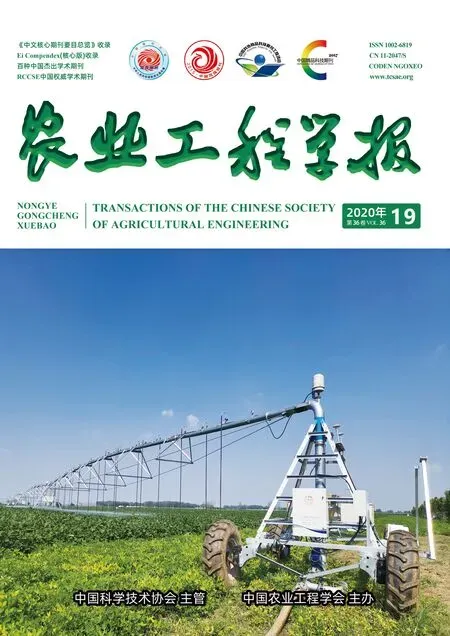挤压稳定化处理对米糠各组分蛋白结构及功能性质的影响
段庆松,段玉敏,肖志刚,,王可心,李 航,王 娜,王依凡,高育哲
·农产品加工工程·
挤压稳定化处理对米糠各组分蛋白结构及功能性质的影响
段庆松1,段玉敏2,肖志刚1,3,王可心3,李 航3,王 娜1,王依凡3,高育哲3※
(1. 沈阳农业大学食品学院,沈阳 110886;2. 沈阳师范大学学前与初等教育学院,沈阳 110034;3. 沈阳师范大学粮食学院,沈阳 110034)
为了研究挤压稳定化处理对米糠各组分蛋白结构和功能性质的影响,选取龙粳31号大米米糠做为原料,采用双螺杆挤压技术对该原料进行稳定化处理。结果表明:米糠各组分蛋白在挤压处理后溶解性、起泡性和持油性显著降低(0.05),持水性、起泡稳定性和乳化稳定性升高,谷蛋白持水性提高的幅度最大,较挤压前提高了39%。米糠谷蛋白的乳化活性与其他2种组分蛋白差异显著,清蛋白和球蛋白较挤压前分别降低5%和10%,谷蛋白乳化活性增加,较挤压前增加8%。结构特性分析结果表明产生这种差异的主要原因不是分子间作用力,而是挤压后各组分蛋白发生重组,形成大的聚集体过程中二级结构的变化截然相反,米糠清蛋白螺旋、转角和无规则卷曲含量都有所降低,折叠含量增势明显提高。挤压后的米糠谷蛋白结构与白蛋白显示出不同的趋势,谷蛋白的二级结构在酰胺I带变化显著,螺旋、转角与无规则卷曲的含量有所提高,折叠的含量下降。结果可为米糠各组分蛋白的工业化制备及在各种食品配方中的应用提供理论支撑。
蛋白;稳定化;溶解性;米糠;清蛋白;球蛋白;谷蛋白
0 引 言
米糠是大米碾磨过程中主要副产物[1],蛋白质量分数为15%~20%,较为丰富,趋近于大豆蛋白,并且其所含的必需氨基酸组成也比较完整,被称为“天赐营养源”,是中国宝贵的资源和财富[2-4]。米糠蛋白主要由清蛋白、球蛋白、醇溶蛋白、谷蛋白这4种蛋白组成。米糠中含有活性较强的脂肪水解酶和脂肪氧化酶,这些物质可通过水解脂质产生游离脂肪酸,导致米糠酸败。同时,由于米糠复杂的成分及植酸等因素的影响,在生产和加工中存在着各成分之间分离困难、应用方面局限等问题。目前,常用于稳定化米糠的方法有挤压法、化学处理法、冷冻法、辐照法、热处理法、微波法等。在食品加工过程中,物理方法稳定化米糠往往比化学方法更可取[5],其对食品本质的影响较小,物理方法作用于米糠使细胞解体,释放蛋白质[6]。从成本和操作上考虑,挤压法普遍被采用。笔者前期研究中发现利用挤压稳定化技术可以抑制酶的活性,从而延长米糠的贮藏时间[7-9]。
挤压稳定化处理在温度80 ℃、高压、剪切力的作用下对米糠中解酯酶的活性进行抑制[10],使米糠中成分的结构和性质发生变化,李红玲[11]等研究发现淀粉经过挤压稳定化处理后,剪切作用破坏淀粉粒,打开分子间的氢键,促进了淀粉的糊化。挤压稳定化处理使米糠中淀粉组分排列紧密的胶束会随着温度升高而降解,利于消化吸收。同时,也能提高膳食纤维利用率,维持膳食纤维对于人体的保健功能[12-14]。在受到物理、化学手段修饰后米糠蛋白结构发生显著变化[15]。Fang[16]等研究了挤压与蛋白分子质量的关系,结果发现,在高温、高压和高剪切力共同作用下,挤压后蛋白分子质量提高。目前,关于挤压稳定化处理米糠的研究,大多集中在优化稳定化参数,而较少有对已经发生一定结构改变的米糠进行稳定化处理的研究[17-19]。本文将新鲜米糠作为原料,比较挤压稳定化处理前后米糠各组分蛋白溶解性、乳化性、二硫键等指标的变化,为米糠各组分蛋白的开发和应用提供理论依据。
1 材料与方法
1.1 原料与试剂
龙粳31号大米米糠,辽宁盛宝天隆米业;SDS-PAGE凝胶电泳试剂盒,考马斯亮蓝R-250,十二烷基硫酸钠,美国Sigma公司;盐酸胍,5,5二硫基-2,2二硝基苯甲酸,上海瑞永生物科技有限公司;其他试剂均为分析纯,天津市永大化学试剂有限公司。
1.2 仪器与设备
DWF-100型电动粉碎机,河北省科研仪器厂;GL-21M高速冷冻离心机,上海市离心机械研究所;Ntcolet 5DXC红外光谱仪,美国Ntcolet 公司;SU3500扫描电镜,日本日立公司;DELTA320型pH计,梅特勒-托利多仪器(上海)有限公司;1645050伯乐电泳仪,美国Bio-rad公司;DS56-Ⅲ型双螺杆挤压机,济南赛信膨化机械有限公司;Zetasizer Nano ZS90分子粒度和zeta电位分析仪,英国Malvern公司;
1.3 试验方法
1.3.1 挤压稳定化
使用螺杆挤压机进行处理,基于此前团队研究结果[10],选择了机筒温度80 ℃,电机功率30 kW,螺杆转速200 r/min,物料含水率20%作为挤压条件,挤出后干燥过筛。
1.3.2 米糠蛋白组分的分离提取
根据Osborn分级原理[20],本试验选用原料新鲜米糠过0.3 mm筛,过筛后粒度范围在250~300m,取100 g放入400 mL蒸馏水中,在40 ℃条件下搅拌2 h,之后在5 000 r/min离心20 min,上清液调pH值4.0,离心沉淀即米糠清蛋白,再通过透析24 h冷冻干燥备用。将沉淀再按100 g:400 mL的比例在盐溶液搅拌2 h,条件同上得米糠球蛋白。将提取球蛋白后残留的残渣沉淀按100 g:400 mL的比例在醇溶液搅拌2 h,条件同上得米糠醇溶蛋白。提取醇溶蛋白后的残渣沉淀按100 g:400 mL的比例在碱溶液搅拌2 h,条件同上得米糠谷蛋白。4种蛋白冻干备用。米糠组分中醇溶蛋白含量较低并且内部组分复杂,难于溶出,限制米糠发展,所以本试验不对米糠醇溶蛋白做深入研究。
1.3.3 米糠蛋白溶解性的测定
准确量取2 mL的蛋白溶于10 mL蒸馏水中。转速8 000 r/min离心20 min,之后采用凯氏定氮法测定上清液的蛋白。用氮溶解度指数表示溶解度,按式(1)计算。

1.3.4 米糠蛋白乳化活性及乳化稳定性的测定
采用Song等[21]的方法进行,取15 mL不同组分蛋白分别与5 mL大豆油混合,以10 000 r/min的速度均质3 min。将50L的乳液与5 mL0.1%(g/mL)的十二烷基硫酸钠完全混合,然后在500 nm处测量(对照组为0.1%(g/mL)十二烷基硫酸钠)。静置10 min后再次从底部各取50L样品,用5 mL0.1%SDS溶液稀释,测吸光度10。乳化性和乳化稳定性分别按式(2)和式(3)计算。
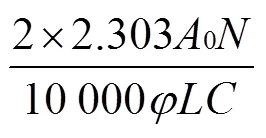
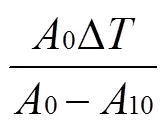
式中0为吸光度值;为稀释倍数;为体系中油相所占比数;为比色池光径,1 cm;为蛋白浓度,g/mL;Δ为2次静置间隔时间差,min。
1.3.5 米糠蛋白的起泡性及起泡稳定性的测定
采用文献[22]的方法进行测定,并加以修改,准确称量0.2 g米糠蛋白样品和20 mL磷酸盐缓冲液(pH 7.0,0.05 mol/L)于50 mL烧杯中混匀。使用均质机以10 000 r/min均质3 min,测均质后体积0,在室温下静置30 min后再此读取液面体积30。起泡能力和起泡稳定性分别按照式(4)和式(5)计算:
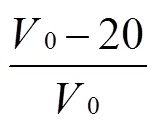
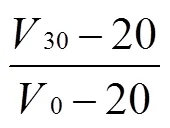
式中0为均质后液面高度,mL;30为静置30 min之后的液面高度,mL。
1.3.6 米糠蛋白持水、持油性的测定
根据Maneerat等[23]的方法并进行修改,称取0.1 g左右米糠蛋白组分溶于5 mL磷酸盐缓冲溶液(pH7.0,0.05 mol/L )和5 mL大豆油中放入10 mL的离心管中,室温下涡旋3 min,速度为5 000 r/min离心20 min,称取质量。持水(油)性按照式(6)计算。

式中为米糠组分蛋白的质量,g;1为米糠组分蛋白质量+离心管质量,g;2为离心后除去上清液后的质量,g。
1.3.7 米糠蛋白巯基、二硫键含量的测定
量取50 mg的米糠蛋白样品,用1 mLTris-甘氨酸缓冲液均匀混合后加入4.7 g的盐酸胍,用缓冲液定容至10 mL。在测定巯基的时候,量取1 mL该液加4 mL脲-盐酸胍溶液和0.05 mLEllman’s试剂,在412 nm处测取吸光值。在测定二硫键的时候,量取1 mL该溶液,加入0.05 mL的巯基乙醇与4 mL的脲-盐酸胍溶液,在25 ℃的温度条件下保温1 h,之后加入10 mL体积分数为12%三氯乙酸,保持25 ℃恒温1 h,速度为5 000 r/min离心10 min,用5 mL体积分数为12%三氯乙酸分两次清洗沉淀物,把沉淀物溶于10 mL的8 mol/L脲中,加0.04 mL的Ellman’s试剂,测取412 nm处的吸光值。
1.3.8 米糠蛋白粒径及电位的测定
根据文献[24]的方法并进行修改,把米糠各组分蛋白溶于磷酸盐缓冲溶液(pH值7.0,0.05 mol/L )中,并配置溶液质量浓度为1 mg/mL,在室温的条件下磁力搅拌3 h之后,采用Zeta sizer Nano ZS 粒度电位仪分析测定。
1.3.9 米糠蛋白扫描电镜的观察
米糠各组分蛋白的微观结构由SEM确定。将米糠各组分蛋白冷冻干燥处理,并用SEM对经稳定化处理和未处理的米糠各组分蛋白进行形貌观察,待观察的样品涂在导电胶带上,并涂上一层5 mm厚的金属,电压5 kV,于500×放大倍数下选择合适视野,拍摄米糠各组分蛋白形貌特征。
1.3.10 米糠蛋白的SDS-PAGE电泳
参考Mehment等[25]的方法,分离胶和浓缩胶分别为12%、5%。蛋白凝胶电泳的上样量为10L。电泳过程中将浓缩胶电压调为80 V,分离胶电压调为120 V。待条带跑完,先用固定液固定再用染色液染色最后用脱色液脱色3~4次,直到蛋白条带清晰,将处理后的凝胶置于凝胶成像系统中进行成像。
1.3.11 米糠蛋白红外光谱测定
取米糠蛋白组分样品1 mg和100 mg溴化钾均匀混合,压制成片,光谱扫描范围为400~4 000 cm-1,分辨率为4 cm-1。使用Peak Fitv4.12软件进行分析,将1 700~1 600 cm-1酰胺Ⅰ带图谱对曲线依次进行平滑、基线校正、Gaussian去卷积、二阶导数拟合等数据处理[26]。
1.3.12 米糠蛋白圆二色光谱测定
利用J-810圆二色谱仪研究挤压稳定化处理对米糠组分蛋白的影响,选用挤压前蛋白和挤压后蛋白作为待测样品,分别检测挤压前后各组分蛋白的圆二色谱。参考Urszula等[27]的方法,并加以改进,取10 mg待测样品加入10 mL的磷酸盐缓冲试剂(pH值7.5,0.005 mol/L)。充分混合之后,把溶液倒入吸收池,将其放在色谱仪中扫描,以190~250 nm作为扫描范围,以100 nm/min为扫描速度,利用Spectra Analysis软件对图谱进行函数平滑,利用仪器附带Jasco二级结构估值程序估算待测样品的二级结构。
1.4 数据处理与统计分析
利用SPSS Statistics 24软件进行ANOVA差异显著分析,显著差异通过邓肯多重范围检验得到,<0.05,差异显著。采用Origin软件进行数据分析和图表处理。
2 结果与分析
2.1 稳定化对米糠各组分功能性质的影响
挤压稳定化前后米糠各组分蛋白的功能性质如表1。米糠经过稳定化后,谷蛋白持水性提高的幅度最大,较挤压前提高39%。提取的米糠各组分蛋白溶解性下降,清蛋白从81%降到70%,球蛋白从69%降到54%,谷蛋白从56%降到46%。挤压后米糠各组分蛋白持油性分别升高至3.59、3.39和3.69 mL/g。该结果与Kristiawan等[28]的研究结果一致。经过高温、高压高剪切形成难溶聚集体,使蛋白溶解性下降。米糠蛋白各组分的起泡能力下降,但谷蛋白的起泡性及起泡稳定性在挤压前后都优于清蛋白和球蛋白,新鲜米糠谷蛋白起泡性及起泡稳定性分别为57%和62%。米糠谷蛋白起泡能力主要是因为在挤压过程中,高温、高压使得谷蛋白结构发生变化,形成更多的无规卷曲结构,展开的蛋白质分子间彼此作用构成更加稳定的网络结构,从而使谷蛋白起泡稳定性增加[29]。米糠谷蛋白的乳化活性与其他两种组分蛋白差异显著,清蛋白和球蛋白较挤压前分别降低5%和10%,谷蛋白增加8%,稳定化后蛋白的乳化能力与溶解性等因素有关[30],对其造成的热变性降低了米糠各组分的乳化能力。挤压前后米糠各组分蛋白的乳化稳定性均有所提高,其中球蛋白乳化稳定性提高幅度最大。造成这种现象的原因是蛋白经挤压处理后,蛋白本身结构由于受到压力和温度的影响,疏松的二级键缔合形成聚合物,各组分米糠蛋白具有亲水和疏水基团,可以吸附油水界面,有稳定乳液的效果,与文献[31]研究结果一致。因此,蛋白质常被作为乳化剂用于乳液食品体系中[32]。

表1 稳定化对米糠各组分功能性质的影响
注:同列不同字母表示差异显著(<0.05)。
Note: Different letters in the same column indicate significant differences (<0.05).
2.2 扫描电镜观察
图1所示为米糠稳定化处理前后扫描电镜下的观察影像。图中可见:挤压过后的米糠各组分蛋白细胞壁被打碎,这是因为挤压过程中经过高剪切的作用,使得米糠各组分蛋白发生形态的改变,同时也改变其组分,形成了不可溶的颗粒,导致挤压过后的米糠各组分蛋白难于溶解,这与之前的溶解性相对应。
2.3 稳定化对米糠各组分蛋白电位的影响
Zeta电位与蛋白溶液稳定性密切相关,对不同处理的米糠蛋白进行Zeta电位测定,结果如图2所示。稳定化处理后的米糠各组分蛋白Zeta电势均有所提高。从图2可见,挤压前后米糠清蛋白Zeta电位从22升到28 mV、米糠球蛋白电位从16到19 mV、米糠谷蛋白电位从23到26 mV,这种变化主要是由于米糠在稳定化处理时高温糊化淀粉,在酸沉过程中与蛋白共沉,使得蛋白表面电荷上升,电势升高。同时在高温条件下蛋白肽链展开,有更多的带电氨基酸富集在蛋白表面,从而使得Zeta电位增加[33]。
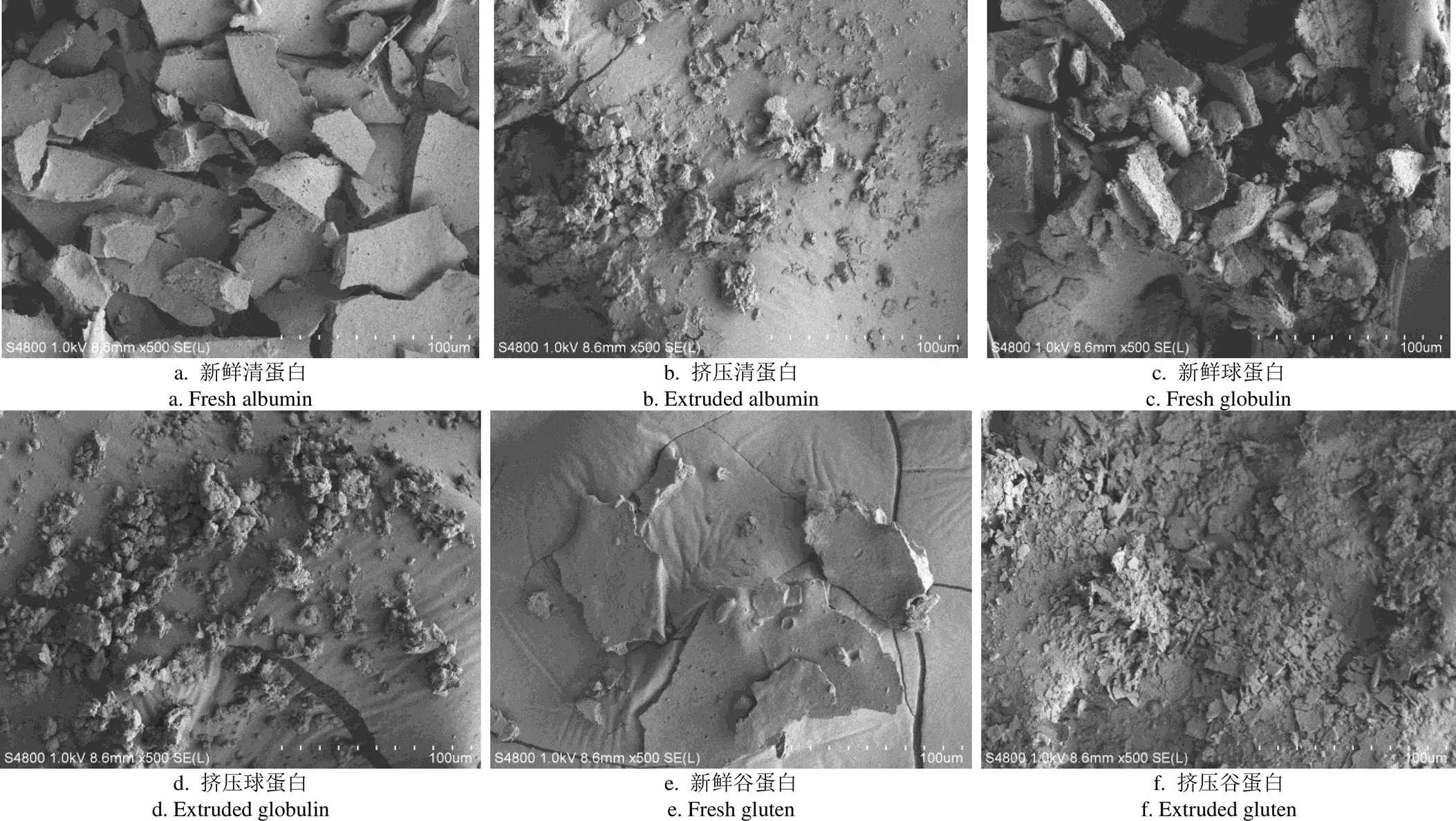
注:放大倍数为500。

图2 稳定化对米糠蛋白电位的影响
2.4 稳定化对米糠各组分蛋白粒径的影响
如图3所示,米糠蛋白各组分粒径分布均匀,均在1 000 nm左右,均呈单峰,在稳定化处理后,可以看出清蛋白左移,粒径变小。球蛋白右移,粒径变大。从图中可以看出稳定化处理对米糠清蛋白、球蛋白影响不大。影响大的是米糠中的谷蛋白,由原来的双峰变成了单峰,粒径均右移,同时体积比也变大了,这跟上文的溶解性相对应,稳定化处理后溶解性降低。吴伟等[34]研究发现花生蛋白形成可溶聚集体粒径增加,本试验的米糠蛋白也论证了这一点。

图3 稳定化对米糠蛋白粒径的影响
2.5 稳定化对米糠各组分蛋白二级结构的影响
酰胺I带是表征蛋白质二级结构最常用的特征频率区域,如图4和表2所示,米糠谷蛋白在1 700 cm-1附近的振动峰是由C—N伸缩振动和N—H面内变形振动所形成的螺旋和折叠,在3 000 cm-1附近的振动峰均是由—CH2和—CH3伸缩振动引起的,表明蛋白部分发生变性[35]。经过稳定化处理后米糠各组分蛋白的螺旋结构、-折叠结构、-转角结构以及无规则卷曲结构都随之改变。但谷蛋白与清蛋白、球蛋白显著不同,米糠清蛋白-螺旋、转角与无规则卷曲的含量都有所下降,折叠的含量有所提升,米糠谷蛋白螺旋、-转角与无规则卷曲的含量有所提升,折叠含量有所下降,米糠球蛋白的变化相对较小。这是由于水溶性的清蛋白通过高温高压的处理之后,其蛋白质的氢键会产生断裂现象,所以使得蛋白发生了部分变性,其结构也就发生了改变。

图4 稳定化对米糠蛋白结构的影响
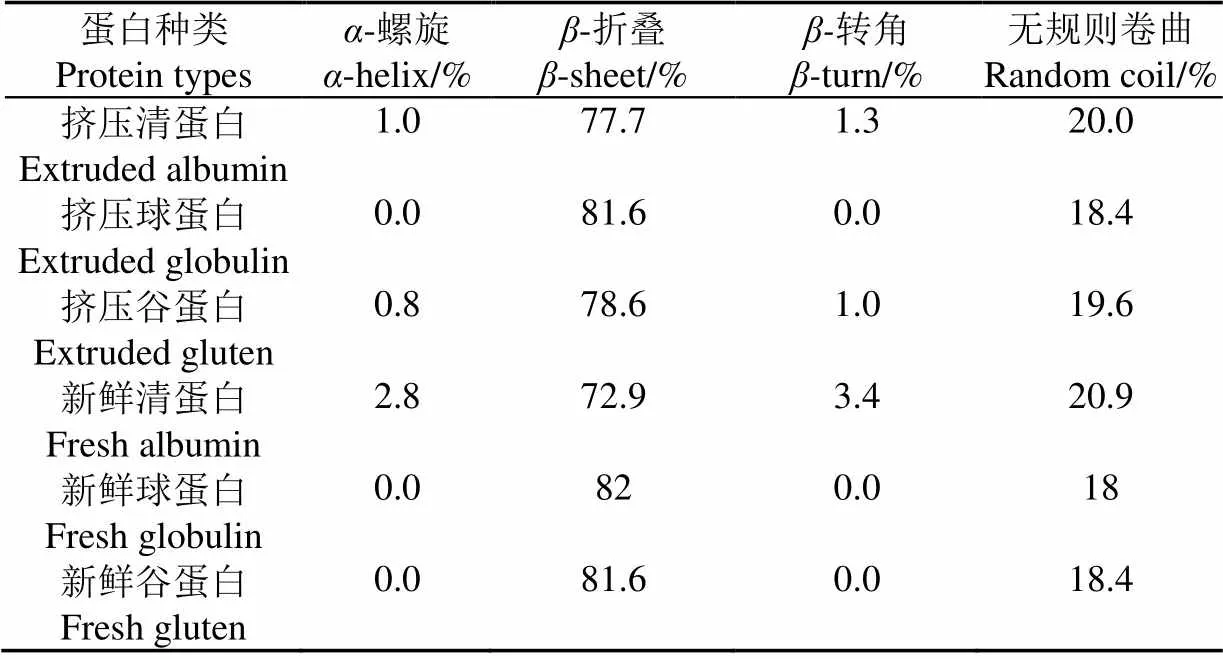
表2 稳定化对米糠蛋白二级结构的影响
2.6 稳定化对米糠各组分蛋白巯基和二硫键的影响
挤压稳定化处理对米糠各组分蛋白游离巯基、总巯基、二硫键含量的影响可见表3,挤压处理后米糠清蛋白、球蛋白、谷蛋白的游离巯基、总巯基、二硫键含量降低。这与文献[36]中所提到的当蛋白质处于加热环境,温度升高导致蛋白分子展开,然后通过氢键、二硫键等相互作用发生聚集,对二硫键造成影响的结论相符合。本试验米糠在高温高压情况下,发生部分变性,米糠中的二硫键发生断裂,导致游离巯基含量和二硫键含量降低。
2.7 稳定化对米糠各组分分子量的影响
如图5可见,从左到右依次为Marker、挤压清蛋白、新鲜清蛋白、挤压球蛋白、新鲜球蛋白、挤压谷蛋白、新鲜谷蛋白。米糠清蛋白条带在94、69、48、30、15 kDa,球蛋白分子量为74、48、30、15 kDa,谷蛋白分子量为48、27、14 kDa。挤压前后的米糠各组分蛋白分子量差异不大,可以从图中看出条带颜色挤压后比挤压前要深,这也说明米糠在挤压后蛋白含量不变,溶解性随着米糠高压高温的处理也随之下降,使得条带颜色变浅。
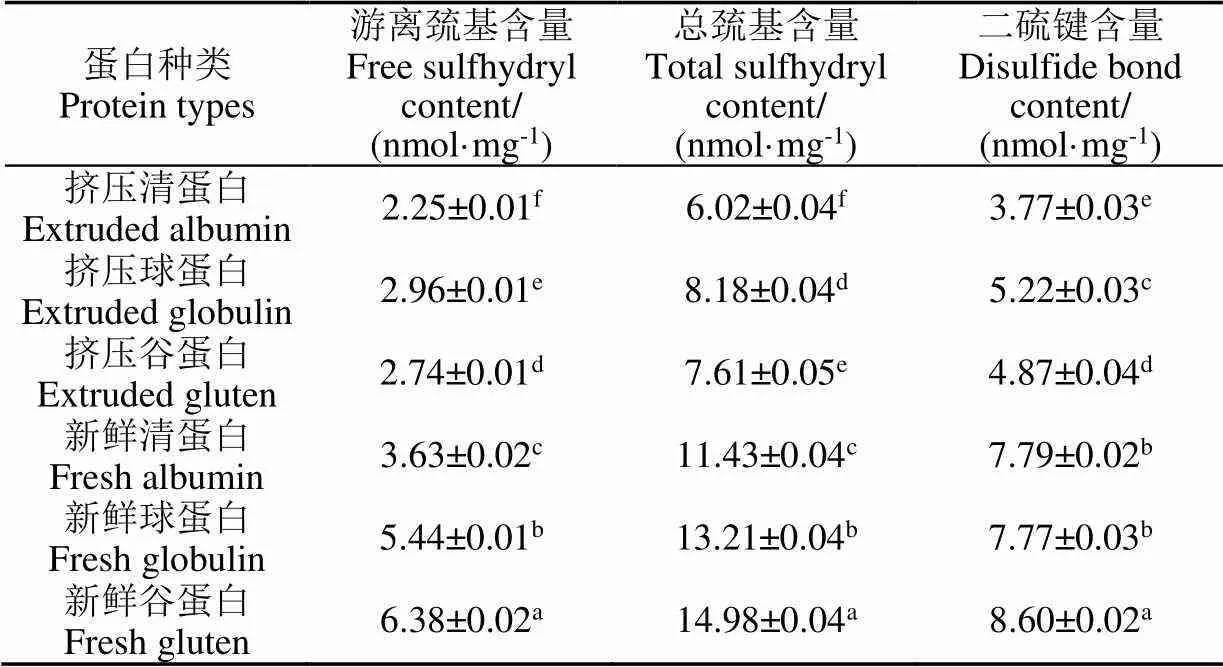
表3 挤压前后米糠蛋白游离巯基、总巯基、二硫键含量
注:同列不同字母表示差异显著(<0.05)。
Note: Different letters in the same column indicate significant differences (<0.05).
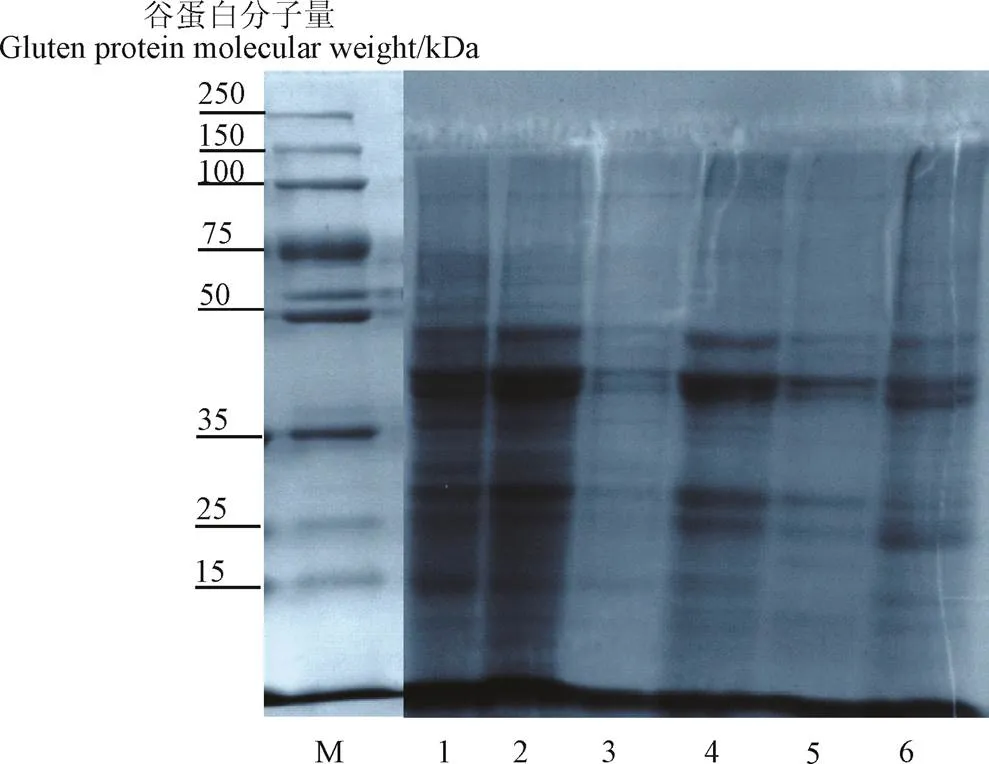
注:1.挤压清蛋白;2.新鲜清蛋白;3.挤压球蛋白;4.新鲜球蛋白;5.挤压谷蛋白;6.新鲜谷蛋白;M.标准品。
3 结 论
1)米糠各组分蛋白在挤压稳定化后功能性质发生了改变,其中米糠谷蛋白持水性显著提高(<0.05),作为功能性的食品配料具有可行性。米糠谷蛋白的乳化活性与其他2种组分蛋白变化相反,谷蛋白乳化活性显著增加(<0.05),蛋白质的乳化特性常应用于肉制品、乳制品、饮料制品及面制品。
2)米糠各组分蛋白在挤压稳定化后结构性质发生了改变,清蛋白、球蛋白、谷蛋白颗粒表面多孔,比表面积较大,对油脂有较大截留作用,可用于乳化剂及改善食品口感及品质。米糠谷蛋白在挤压稳定化后小分量蛋白发生聚集过程中二级结构-折叠结构向-螺旋、-转角与无规则卷曲结构的转化是提高其乳化活性的主要原因。
[1] Chagam R, Lalmuan K et al. Effects of polishing on proximate composition, physico-chemical characteristics, mineral composition and antioxidant properties of pigmented rice[J]. Rice Science, 2017, 24(5): 241-252.
[2] 黄皓,王珍妮,李莉,等. 甘油水溶液提取米糠多酚绿色工艺优化及多酚种类鉴定[J]. 农业工程学报,2019,35(4):305-312.
Huang Hao, Wang Zhenni, Li Li, et al. Optimization of green extraction process and identification of polyphenols variety from rice bran using glycerol/water system[J]. Transactions of the Chinese Society of Agricultural Engineering (Transactions of the CSAE), 2019, 35(4): 305-312. (in Chinese with English abstract)
[3] Bhagavathi S S, Periyanaina K, Chaiyavat C. A comprehensive review on anti-diabetic property of rice bran[J]. Asian Pacific Journal of Tropical Biomedicine, 2018, 8(1): 79-84.
[4] 郑煜焱,曾洁,李晶,等. 米糠蛋白的组成及功能性[J].食品科学,2012,33(23):143-149.
Zheng Yuyan, Zeng jie, Li Jing, et al. Composition and functionality of rice bran protein[J]. Food Science, 2012, 33(23): 143-149. (in Chinese with English abstract)
[5] Singh T P, Sogi D S. Comparative study of structural and functional characterization of bran protein concentrates from superfine,fine and coarse rice cultivars[J]. International Journal of Biological Macromolecules, 2018, 111: 281-288.
[6] Luca A, Jonathan O, Alan L. Kelly, et al. The composition, extraction, functionality and applications of rice proteins: review[J]. Trend in Food Science and Technology, 2017, 64(6): 1-12.
[7] 王长远,郝天舒,张敏. 干热处理对米糠蛋白结构与功能特性的影响[J]. 食品科学,2015,36(7):13-18.
Wang Changyuan, Hao Tianshu, Zhang Min. Effect of dry heat treatment on the structure and functional properties of rice bran protein[J]. Food Science, 2015, 36(7): 13-18. (in Chinese with English abstract)
[8] 肖俊琪,翟爱华,李嘉庆,等. 蒸汽爆破预处理辅助提取米糠蛋白的工艺研究[J]. 中国食品添加剂,2018(9):134-141.
Xiao Junqi, Zhai Aihua, Li Jiaqing, et al. Study on the technology of steam explosion pretreatment assisted extraction of rice bran protein[J]. Chinese food additives, 2018(9): 134-141. (in Chinese with English abstract)
[9] Suphat Phongthai, Seung-Taik Lim, Saroat Rawdkuen. Optimization of microwave-assisted extraction of rice bran protein and its hydrolysates properties[J]. Journal of cereal Science, 2016, 70(7): 146-154. (in Chinese with English abstract)
[10] 高洋,肖志刚,刘海飞,等. 全脂米糠过氧化物酶挤压钝化参数研究[J]. 中国粮油学报,2014,29(6):79-86.
Gao Yang, Xiao Zhigang, Liu Haifei, et al. Study on extrusion passivation parameters of peroxidase of whole fat rice bran[J]. Chinese Journal of cereals and oils, 2014, 29(6): 79-86. (in Chinese with English abstract)
[11] 李红玲,田娟娟,刘冰,等. 中试生产稳定化全脂米糠粉中淀粉糊化度的研究[J]. 粮食与饲料工业,2013(4):34-37,43.
Li Hongling, Tian Juanjuan, Liu Bing, et al. Study on the gelatinization degree of starch in the pilot production of stabilized whole-fat rice bran powder[J]Food and feed industry, 2013(4): 34-37, 43. (in Chinese with English abstract)
[12] 于殿宇,王彤,王旭,等. 挤压膨化预处理工艺优化提高大豆蛋白粉品质[J]. 农业工程学报,2018,34(4):285-292.
Yu Dianyu, Wang Tong, Wang Xu, et al. Optimization of extrusion pretreatment process to improve the quality of soybean protein powder[J]. Transactions of the Chinese Society of Agricultural Engineering (Transactions of the CSAE), 2018, 34(4): 285-292. (in Chinese with English abstract)
[13] 蒋雅茜. 米糠膳食纤维对大米淀粉理化特性的影响[D]. 长沙:中南林业科技大学,2014.
Jiang Yaqian. The Effect of Rice Bran Dietary Fiber on the Physical and Chemical Properties of Rice Starch[D]. Changsha: Central South University of Forestry and Technology, 2014. (in Chinese with English abstract)
[14] 徐树来. 挤压加工对米糠主要营养成分影响的研究[J]. 中国粮油学报,2017(3):12-16.
Xu Shulai. Study on the effect of extrusion processing on the main nutrients of rice bran[J]. Chinese Journal of cereals and oils, 2017(3): 12-16. (in Chinese with English abstract)
[15] Zhu S M. Lin S L, Yu Y. et al. Enhancement of functional properties of rice bran proteins by high pressure treatment and their correlation with surface hydrophobicity[J]. Food Bioprocess Technol, 2017, 10: 417-317.
[16] Fang Yanqiang, Zhang Bo, Wei Yimin. Effects of the specific mechanicalenergy on the physicochemical properties of texturized soy protein during high-moisture extrusion cooking[J]. Journal of Food Engineering, 2014, 121(1): 32-38.
[17] 周麟依,孙玉凤,吴非. 丙二醛氧化对米糠蛋白结构及功能性质的影响[J]. 食品科学,2019,40(12):98-107.
Zhou Linyi, Sun Yufeng, Wu Fei. The effect of malondialdehyde oxidation on the structure and functional properties of rice bran protein[J]. Food Science, 2019, 40(12): 98-107. (in Chinese with English abstract)
[18] 尤翔宇. 过氧自由基和丙二醛氧化对米糠蛋白结构、功能性质和消化性质的影响[D]. 长沙:中南林业科技大学,2019.
Long Xiangyu. Effects of Peroxy Free Radicals and Malondialdehyde Oxidation on the Structure, Functional Properties and Digestibility of Rice Bran Protein[D]. Shangsha: Central South University of Forestry and Technology, 2019. (in Chinese with English abstract)
[19] Lv Shiwen , He Leiyu, Sun Lihui. Effect of different stabilisation treatments on preparation and functional properties of rice bran proteins[J]. Czech Journal of Food Sciences, 2018, 36: 57-65.
[20] Li Hongrui, Guo Hai ,Zhu Liqin, et al. Optimization of extraction technology for rice bran Oil[J]. Agricultural Biotechnology, 2013, 2(5): 52-54, 57.
[21] Song Yongling, Qin Ruiqi, Yang Shaoming, et al. Improvement of foaming and emulsifying properties of gluten by conjugation with Fructose through maillard reaction[J]. Grain Oil Science and Technology, 2018, 1(3): 119-125.
[22] 黎卫. 芡实蛋白组分的结构表征及其理化性质研究[D]. 无锡:江南大学,2015.
Li Wei. The Structural Characterization and Physical and Chemical Properties of Gorgon Protein Components[D]. Wuxi: Jiangnan University, 2015. (in Chinese with English abstract)
[23] Maneerat J, Suchada P, Hirofumi T, et al. Effect of high-pressure homogenization on stability of emulsions containing zein and pectin[J]. Asian Journal of Pharmaceutical Sciences, 2017, 12(1): 21-27.
[24] Li Dan, Zhao Yue, Wang Xu, et al. Effects of (+)-catechin on a rice bran protein oil-in-water emulsion: Droplet size, zeta-potential, emulsifying properties, and rheological behavior[J]. Food Hydrocolloids, 2020, 98(6): 145-156.
[25] Mehment Hayta. Optimization of antihypertensive and antioxidant hydrolysate extraction from rice bran proteins using ultrasound assisted enzymatic hydrolysis[J]. Journal of Food Measurement and Characterization, 2020, 14: 2578-2589.
[26] 夏宁. 喷射蒸煮制备米糠、碎米蛋白及其功能性研究[D].广州:华南理工大学,2012.
Xia Ning. Study on the Preparation of Rice Bran and Broken Rice Protein by jet Cooking and Their Functions[D]. Guangzhou: South China University of Technology, 2012. (in Chinese with English abstract)
[27] Urszula, Katarzyna W. The interaction between human serum albumin and antidiabetic agent-exenatide: determination of the mechanism binding and effect on the protein conformation by fluorescence and circular dichroism techniques[J]. Journal of Biomolecular Structure and Dynamics, 2020, 38(8): 2267-2275.
[28] Kristiawan M, Micard V, Maladira P, et al. Multi-scale structural changes of starch and proteins during pea flour extrusion[J]. Food Research International, 2018, 108: 203-215.
[29] Li Rui, Cui Qiang, Wang Guorong, et al. Relationship between surface functional properties and flexibility of soy protein isolate-glucose conjugates[J]. Food Hydrocolloids, 2019, 95: 349-357.
[30] 吴晓娟,王晓婵,张家妮,等. pH碱性偏移结合热处理对米糠蛋白结构和功能性质的影响[J]. 食品科学,2020:1-13.
Wu Xiaojuan, Wang Xiaochan, Zhang Jiani, et al. Effects of pH alkaline shift combined with heat treatment on the structure and functional properties of rice bran protein[J]. Food Science, 2020: 1-13. (in Chinese with English abstract)
[31] 王婧. 热处理对燕麦蛋白质理化与功能特性影响的研究[D]. 西安:陕西师范大学,2019.
Wang Jing. Study on the Effect of Heat Treatment on the Physical, Chemical and Functional Properties of Oat Protein[D]. Xi’an: Shanxi Normal University. (in Chinese with English abstract)
[32] He Yao. Structure and functional properties of protein from defatted Camellia oleifera seed cake[J]. International Journal of Food Properties, 2019, 22(1): 1283-1295.
[33] Ferraris S, Cazzola M, Peretti V, et al. Zeta potential measurements on solid surfaces for in vitro biomaterials testing: Surface charge, reactivity upon contact with fluids and protein absorption[J]. Frontiers in Bioengineering and Biotechnology, 2018, 6: 60.
[34] 吴伟,吴晓娟,蔡勇建,等. 米糠贮藏期间米糠谷蛋白结构变化的研究[J]. 中国粮油学报,2017,32(7):98-102,120.
Wu Wei, Wu Xiaojuan, Cai Yongjian, et al. Study on the structural changes of rice bran gluten during storage of rice bran[J]. Journal of the Chinese Cereals and Oils Association, 2017, 32(7): 98-102, 120. (in Chinese with English abstract)
[35] 谢凤英,马岩,王晓君,等. 拉曼光谱分析荞麦多酚对米糠蛋白结构的影响[J]. 食品科学,2017,38(3):32-36.
Xie Fengying, Ma Yan, Wang Xiaojun, et al. Raman spectroscopy analysis of the effect of buckwheat polyphenols on the structure of rice bran protein[J]. Food Science, 2017, 38(3): 32-36. (in Chinese with English abstract)
[36] 何兴芬. 热处理对藜麦蛋白质功能特性、结构及体外消化的影响[D]. 兰州:甘肃农业大学,2020.
He Xingfen. The Effect of Heat Treatment on the Functional Properties, Structure and in Vitro Digestion of Quinoa Protein[D]. Lanzhou: Agricultural University of Gansu, 2020. (in Chinese with English abstract)
Effects of extrusion stabilization on protein structure and functional properties of rice bran components
Duan Qingsong1, Duan Yumin2, Xiao Zhigang1,3, Wang Kexin3, Li Hang3, Wang Na1, Wang Yifan3, Gao Yuzhe3※
(1.,,110886,; 2.,,110034,;3.,,110034,)
Rice bran is the main by-product of the rice milling process with high protein content. Although there is a large amount of rice bran in China, most of it is used to raise animals. Therefore, for the economic benefits of the rice processing industry, it is inevitable to fully develop the added value of rice bran. Longjing No.31 rice bran was chosen as the protein sourcein order to study the effect of extrusion stabilization treatment on the protein structure and functional properties of each component of rice bran, , and effects of rice bran extrusion stabilization using twin-screw extruder on structural and functional properties of rice bran protein fractions were also investigated. The results showed that the solubility, foamability and oil-holding capacity of each component protein of rice bran were significantly reduced after extrusion treatment (<0.05), this is because insoluble aggregates are formed after high temperature, high pressure and high shear. The water-holding capacity, foaming stability and emulsion stability were increased, among which the water holding capacity of gluten increased the most, 39% higher than that before extrusion. After extrusion, the structure of gluten changed, forming more random coil structures, and the unfolded protein molecules interacted with each other to form a more stable network structure, thereby increasing the foaming stability of gluten.As well as, its emulsifying activity was significantly different from that of other protein fractions. On the other hand, the albumin and globulin contents decreased by about 5% and 10%, while gluten increased by about 8% after extrusion, respectively. The emulsifying ability of rice bran protein was related to factors such as solubility, and the thermal denaturation caused by stabilization reduced the emulsifying ability of each component of rice bran. Structural analysis indicated that changes in protein fractions after extrusion mainly attributed to a recombination among them, which indicated by differences in the secondary structure. The-helix,-turn, and random coil contents of the albumin decreased significantly after extrusion, while the content of-sheet folding increased significantly. Moreover, the rice bran gluten showed a different trend from that of albumin, and the secondary structure of gluten changed significantly in the amide I zone, the content of-helix,-turn and random coil increased, and the content of-sheet decreased. After high temperature and high pressure treatment, the hydrogen bond of the protein was broken, so the protein was partially denatured and its structure was also changed. The results can help in understanding changes occur in structural and functional properties of rice bran protein fractions during extrusion to promote the utilization of rice bran protein in the food industry.
protein; stabilization; solubility; rice bran; albumin; globulin; gluten
段庆松,段玉敏,肖志刚,等. 挤压稳定化处理对米糠各组分蛋白结构及功能性质的影响[J]. 农业工程学报,2020,36(19):283-290.doi:10.11975/j.issn.1002-6819.2020.19.032 http://www.tcsae.org
Duan Qingsong, Duan Yumin, Xiao Zhigang, et al. Effects of extrusion stabilization on protein structure and functional properties of rice bran components[J]. Transactions of the Chinese Society of Agricultural Engineering (Transactions of the CSAE), 2020, 36(19): 283-290. (in Chinese with English abstract) doi:10.11975/j.issn.1002-6819.2020.19.032 http://www.tcsae.org
2020-07-18
2020-09-10
辽宁省农业攻关及产业化指导计划项目(2019JH8/10200020);辽宁省重点研发计划项目(1584949193607);辽宁省高等学校基本科研项目(LQN201704)
段庆松,研究方向为粮食油脂及植物蛋白工程。Email:1392694031@qq.com
高育哲,博士,讲师,研究方向为粮食油脂及植物蛋白工程。Email:gaoyuzhe_66@163.com
10.11975/j.issn.1002-6819.2020.19.032
TS213.3
A
1002-6819(2020)-19-0283-08

